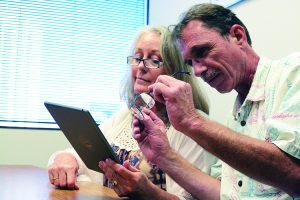Technology is ever-advancing these days with information on new devices everywhere. For early adopters this is seen as helpful and even normal. However, for some seniors, adapting to new devices can be challenging due to physical limitations. Vision loss is one of the more common problems experienced, as is Age Related Macular Degeneration (AMD) that typically affects older adults.
 Millions of Americans every year are affected by AMD, which destroys central vision leaving only the peripheral vision. Those affected may be unable to see the faces of their family members, drive a car, or read a newspaper. Using a mobile device can have the same results. Nearly 1 in every 3 adults over the age of 75 is currently affected with AMD. According to Dr. Chris Knobbe, clinical associate professor emeritus at the University of Texas Southwestern Medical Center, “AMD is an epidemic — world-wide. Globally, 1 in every 11 persons over the age of 50 has some degree of AMD.”
Millions of Americans every year are affected by AMD, which destroys central vision leaving only the peripheral vision. Those affected may be unable to see the faces of their family members, drive a car, or read a newspaper. Using a mobile device can have the same results. Nearly 1 in every 3 adults over the age of 75 is currently affected with AMD. According to Dr. Chris Knobbe, clinical associate professor emeritus at the University of Texas Southwestern Medical Center, “AMD is an epidemic — world-wide. Globally, 1 in every 11 persons over the age of 50 has some degree of AMD.”
The good news is technology is improving for those with vision loss like AMD. Currently there are many tools which can help individuals to read their devices, from simple magnifiers and brighter reading lights, to more sophisticated screen readers and applications. The accommodation of selecting larger fonts and web page sizes has also been available across media to make information more legible. These visual aids have helped those with vision impairments to maximize their usable vision and make better use of devices and technology. The use of voice command devices has also become more mainstream and should be considered for those with vision impairments. Amazon has ECHO, a home voice command device, Samsung has a smart TV which listens to voice commands, and Sony has their smart watch with voice commands.
Bridging these gaps between seniors and technology can also be a challenge for caregivers sometimes, given the limitations that vision loss can have on using devices. But once these hurdles are cleared, research shows that adults older than 65 using smartphones or other electronic devices are more likely to become daily internet users. While some seniors may be reluctant to adopt technology due to their limitations, caregivers can help by doing a few simple things:
- Avoid complex devices with distracting features.
- Use technology that accommodates physical limitations.
- Choose devices relevant to user needs and values.
- Encourage technology that is socially rewarding.
- Be their technical support.
Once on the internet, seniors using devices with social media apps, such as Facebook, Instagram, and Twitter, are more in touch and engaged with others. Forrester Research also showed in their report, “Digital Seniors”, that 60 percent of all U.S. seniors (those 65 and older) are online and, of those, roughly half are also using Facebook. “Many people have the misunderstanding that seniors are averse to technology. I don’t find that true at all,” said registered nurse, Kari Wheeling. “It’s the simpler things like Arthur-itis, or forgetting their glasses on their head, that gets in the way.”
ATTENTION PLUS CARE HOME HEALTH CARE
Accredited by The Joint Commission
1580 Makaloa St., Ste. #1060, Honolulu HI 96814
808-739-2811 | www.attentionplus.com
AGING IN HAWAII EDUCATIONAL OUTREACH PROGRAM by Attention Plus Care — a program providing resources for seniors and their families, covering different aging topics each month. For class information and upcoming topics, call 808-440-9356.


Leave a Reply